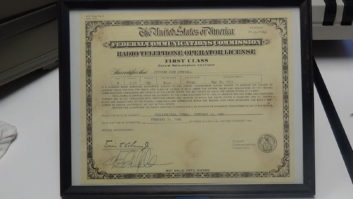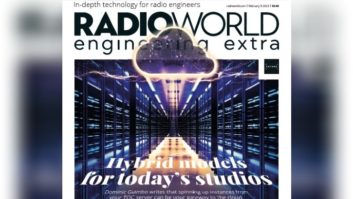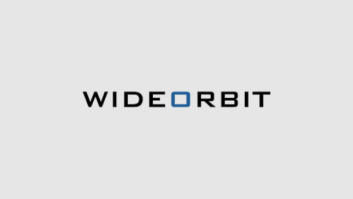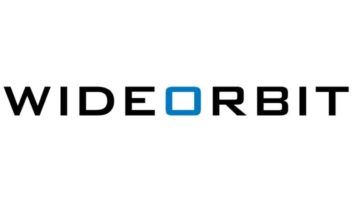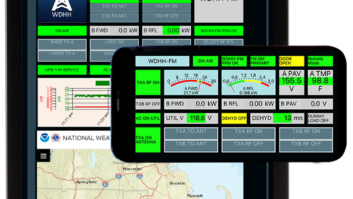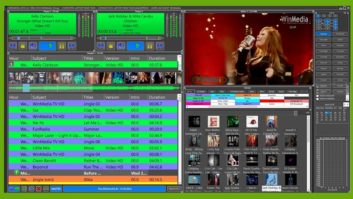Twenty years ago, as consolidation among radio companies was running rampant, automation systems became even more important than they’d been prior. Radio companies were promising new efficiencies to their investors, and automation provided one way to achieve that. Most manufacturers that work in this space have developed at least several generations of new systems since, with dramatically more power and functionality.
Over the last 15 years, initial requirements turned into basic features. Virtually all automation systems are going to allow you to do the following:
- Scheduling of a music log, and the playback of songs according to the log;
- Scheduling of commercial content, and the playback of spots according to the log;
- Log reconciliations, so that you can prove spots ran over-the-air;
- In-house voice-tracking;
- Embedded recorder/editor.
Without those basic features, you don’t have a system that is of use in a real radio station. Nowadays you must be able to accommodate voice-tracking for local and remote talent; you likely need content management features for streaming audio or on-demand features like podcasting along with management of metadata (for “now playing” features) and likely “social media” functions as well. The ability to access the system remotely via a smartphone has grown in importance.
Let’s look at several major players and see what they are offering over and above the five basic features.
ENCO
ENCO has its roots in the early 1980s. The Michigan-based company describes its DAD system thus: “Highly redundant and flexible architecture allows for infinite scalability and high performance ensuring your specific needs will be met into the future.” From an engineering standpoint, here are its most salient features:
- DAD integrates with many types of broadcast equipment;
- According to the company the new DAD Engine can support up to 16 playlists running simultaneously from one workstation;
- Content can be shared across multiple streams (outputs). The system performs breakaways for different commercials, liners and jingles;
- It has an open API to facilitate integration with existing or new technologies.
As the end users, programmers will appreciate that playlists can have voice-tracks added from anywhere via a web browser, iPad or Windows PC. VPN access is unnecessary. DAD features automatic content ingestion, and directly integrates with Adobe Audition and Hindenburg Journalist Pro.

And certainly not least, the traffic department should find these features useful: Log changes can be made at any time; the system automatically takes music logs and commercial logs and merges them. Music and/or commercial logs can be re-exported without having to re-merge logs afterwards; and DAD comes with its own integrated scheduling software plus what ENCO calls “tight bidirectional interface to leading scheduling systems.”
DAD is available as software-only, running on off-the-shelf PC hardware, or as a turnkey system delivered with ENCO’s hardware configurations.
ARRAKIS SYSTEMS
Digilink-HD-Complete Arrakis, based in Colorado, is a full-featured automation system, and with it you can connect up to 10 on-air studios and an “unlimited” number of auxiliary studios. From a single networked station users can change schedules, add audio to specific stations and manage the audio database. With Digilink HD Tools, users have remote access to all networked stations.

The live-assist functions with Digilink-HD give each programmer access to all major components for live-assist. The system is touchscreen-compatible, and supports multiple monitors.
As one would expect, Digilink-HD gives the user the ability to create voice-tracks using its built-in segue editor and voice track recorder. The system also has a native recorder which can be used for phone calls, and it supports satellite automation and ball game automation.
RCS
RCS, headquartered in New York and with its roots in music scheduling, uses the tag line “the world’s largest broadcast software company.” According to the company, Zetta “takes a modular approach to workflow. All functions have a launcher app looking after the services and will restart them if they stop unexpectedly.” Playout audio is separate from the Sequencer, which is separate from the user interface, which of course, is just a remote control for the system and can be run on any workstation.
Zetta2GO is a suite of applications that lets users control the Zetta automation/playout system from a smartphone or tablet. You can manipulate what’s on the air from any place with an internet connection. Remote users can see the logs, Hot Keys and the segue/voice-track editor.

Zetta was developed on SQL Server to enable flexibility for future expansion. It integrates with other RCS products such as GSelector, RCS News and Aquira. With the RCS “Living Log” changes are instantly reflected everywhere, allowing for easy coordination between all station departments that are involved.
Some other salient features for Zetta include:
- ZCast, which enables sites to share audio assets, logs, voice-tracks with heads/tails, segue transitions and splits between stations and databases;
- Zetta Splits, a feature that lets a master station send a signal, using TCP or serial, to local stations to play their own local spots and links, and then it rejoins the master station after the break. Splits stations can be used for internet streaming stations, network programming or simulcasting;
- Emergency On-Air Backup — Each computer in Zetta can be configured to have the ability to “Go Local.” This means the local computer will use a copy of the main database that is saved and synchronized on to the local computer;
- Site Replication, which keeps a copy of most of your entire database in sync somewhere else — off- premises. Hardware/computer- related items are not synched so that users can have local hardware configured to take a system to air if necessary.
BSI
Oregon-based Broadcast Software International, launched in the late 1980s and acquired a decade later by Cumulus Media, offers Simian 2.3, the latest iteration of its Simian radio automation.

Some of its new features include:
- ● 32-Bit/64-Bit-Compatible Audio Engine: For use on Windows 7 64-bit, Windows 8 32-/64-bit, Windows 8.1 32-/64- bit, and Windows 10 32-/64-bit;
● Simian File Sync Utility: Sync and backup audio files and logs, trigger sets, Hot Key sets;
● New Weather and Forecast Background Service: Built-in utility to retrieve weather and forecast information;
● Configurable Segue Fader Curve: User sets the shape of the fade on segue;
● New Email Notification Engine: Receive email notifications when there is a playback/auto-replace error, crash recovery was engaged after a restart, Simian is closed by the user, program or hardware options are accessed by user, or the security options window is accessed by the user;
● New Hardware Connector Functionality: Add-on hardware connector background services for integration between Simian and third-party hardware.
OMT
Like many of the systems here, iMediaTouch by Winnipeg-based OMT has evolved substantially over the years since touchscreen control started showing up in studios in the 1980s.

Its features include advanced voice-tracking features both in-studio and from remotes locations, and a satellite interface that facilitates networked talk programming and sports broadcasts (“all done in one daily log”).
For station groups, iMediaTouch offers centralized audio distribution and remote voice-tracking. For noncommercial stations, the system offers compatibility with NPR Content Depot.
The system has functionality to interface with consoles, of course, as well third-party products from MusicMaster, Wheatstone and Axia. “Outbound” IP functionality includes metadata output, album cover and real time WMA encoding.
The user interface can be set up for either touchscreen or mouse/keyboard, depending upon station or corporation preference. An optional on-air screen audio library displays with drag’n drop into the main log and Hot Key pages. And, an enhanced phone bit recorder and waveform editor is available from the main on-air screen.
iMediaTouch offers a system emergency operation (operated from a local hard drive or redundant server) with complete restoration of all configuration settings and database entries in the event of a “server down” circumstance.
France-based software provider WinMedia Group acquired OMT Technologies in 2017; the company exhibited as Win-OMT at the spring NAB Show.
DJB
DJB Radio Automation Software runs on a PC, using either audio cards or Axia’s Livewire or WheatNet IP (with optional interfaces). According to its literature, DJB Radio works with any traditional audio card that works with Windows Direct Sound. “Start with DJB Radio Automation Software, then upgrade your hardware in stages. Switch over to AoIP when your infrastructure is ready.” The company is headquartered in Las Vegas and managed by Ron Paley, whose family acquired the DJB technology in 2012.

Some of its important features include:
- Wave Editor: In the on-air studio, users can quickly edit phone calls or clean up recordings made with the Background Recorder to get them ready to air;
- Voice-Tracking: Has two modes — regular voice-tracking where users listen to the segue while recording the break and a faster Speed Voice Tracking, which has a time counter and record-without-listening function;
- Log Editor: It works in real time, with changes reflected instantly;
- Scheduling of Programs: DJB can interface with major traffic systems and music scheduling programs;
- Central Server: Each station can have its own independent set of music categories, logs are managed station by station, but each station can share the commercial library and other programming;
- Now Playing/Streaming: Several options for putting “now playing” metadata information on a website and output to an RDS encoder. SECURENET, Shoutcast, Live 365 and TCP-IP output settings built in to the automation;
- Background Recorder: The built-in Background Recorder uses a time-scheduled start-stop or triggered start-stop to record programs automatically and drop them into the audio database for later playback.
BROADCAST ELECTRONICS
AudioVault has been a prominent name in this sector for decades and has evolved into AudioVault Flex.

The system can be built using off-the-shelf audio cards, or it can use IP audio routing (the end-user decides). Engineering can repurpose content for use elsewhere such as new internet-only content or use on an HD2 channel. Stations can also syndicate shows individualized by affiliate anywhere in the world.
The system is scalable; it can be expanded from a single workstation to a multiple-location network and new capabilities can be added as the station needs. Engineering (and talent) can access the system remotely and now by a smartphone via the Flex mobile app.
BE says talent can set up any number of screen presets based on their preferences, show formats and other individual or workgroup uses; they can record and log audio from practically any source for long-term storage or short-term auditing; they can cut and paste audio clips, and they can record news actualities and phone bits. They can operate the system in a fully automated fashion, in live-assist, or off of satellite (or any combination of all three).
Naturally there are features for production and traffic personnel; spots can be dubbed in from agencies; music can be ripped from a CD, or imported in any WAV, MP3 or other standard audio file. With a feature called Perfect Timing, stretch/squeeze functions are used to keep the various streams all aligned with one-another from a timing standpoint.
Headquartered in Quincy, Ill., BE was acquired by Elenos last year.
WIDEORBIT
WideOrbit Automation for Radio includes centralized content and playlists that allow users to record, import, edit and convert music for automatic distribution to the right markets; user can instantly change spots, music or other programming elements.
Remote management allows for management of the system from any browser; multiple-market voice-tracking allows the station or group to use talent from other markets and record voice tracks remotely — and to then deliver to any station via a web browser.
Enhanced MusicMaster Integration provides integration with this scheduling software for song replacement, real-time reconciliation, advanced music searching and automatic song card creation. WO Traffic Integration allows for use of WO Traffic for live log editing, electronic playlist delivery, real-time reconciliation and automatic run date synchronization. Audio Finder allows the station to manage the audio library centrally and search other markets for content. Customizable interfaces allows users to make changes to the UI to better suit their individual needs.
Like other large systems in a radio facility — consoles, routers, transmitters — an automation system should be purchased based not only on feature set but also on the purchaser’s personal preference and history with a particular brand. It’s natural to take that approach; it’s also wise to see what other systems are out there before making a commitment to a system which is expensive and expected to have a long life. Do your homework!
Doug Irwin, CPBE AMD DRB, is vice president of engineering at iHeartMedia in Los Angeles and a technical advisor to Radio World. His Trends in Technology columns will appear here regularly.





